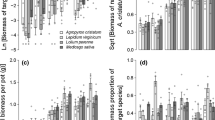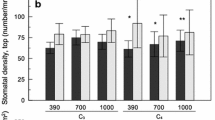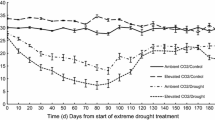Abstract
The invasion of African grasses into Neotropical savannas has altered savanna composition, structure and function. The projected increase in atmospheric CO2 concentration has the potential to further alter the competitive relationship between native and invader grasses. The objective of this study was to quantify the responses of two populations of a widespread native C4 grass (Trachypogon plumosus) and two African C4 grass invaders (Hyparrhenia rufa and Melinis minutiflora) to high CO2 concentration interacting with two primary savanna stressors: drought and herbivory. Elevated CO2 increased the competitive potential of invader grasses in several ways. Germination and seedling size was promoted in introduced grasses. Under high CO2, the relative growth rate of young introduced grasses was twice that of native grass (0.58 g g−1 week−1 vs 0.25 g g−1 week−1). This initial growth advantage was maintained throughout the course of the study. Well-watered and unstressed African grasses also responded more to high CO2 than did the native grass (biomass increases of 21–47% compared with decreases of 13–51%). Observed higher water and nitrogen use efficiency of invader grasses may aid their establishment and competitive strength in unfertile sites, specially if the climate becomes drier. In addition, high CO2 promoted lower leaf N content more in the invader grasses. The more intensive land use, predicted to occur in this region, may interact with high CO2 to fincreasesavor the African grasses, as they generally recovered faster after simulated herbivory. The superiority of invader grasses under high CO2 suggests further in their competitive strength and a potential increased rate of displacement of the native savannas in the future by grasslands dominated by introduced African species.


Similar content being viewed by others
References
Anderson LJ, Maherali H, Johnson HB, Polley HW, Jackson RB (2001) Gas exchange and photosynthetic acclimation from subambient to elevated CO2 in a C3–C4 grassland. Glob Change Biol 7:693–707
Barger NN, D’Antonio CM, Ghneim T, Brink K, Cuevas E (2002) Nutrient limitation to primary productivity in a secondary savanna in Venezuela. Biotropica 34:493–501
Baruch Z (1996) Ecophysiological aspects of the invasion by African grasses and their impact on biodiversity and function of Neotropical savannas. In: Solbrig O, Medina E, Silva J (eds) Biodiversity and savanna ecosystem processes, vol 121. Springer, Berlin Heidelberg New York, pp 79–93
Baruch Z (2005) Vegetation-environment relationships and classification of the seasonal savannas in Venezuela. Flora (in press)
Baruch Z, Bilbao B (1999) Effects of fire and defoliation on the life history of native and invader C4 grasses in a Neotropical savanna. Oecologia 119:510–520
Baruch Z, Fernández DS (1993) Water relations of native and introduced C4 grasses in a Neotropical savanna. Oecologia 96:179–185
Baruch Z, Gómez JA (1996) Dynamics of energy and nutrient concentration and construction costs in a native and two alien C4 grasses from two Neotropical savannas. Plant Soil 181:175–184
Baruch Z, Ludlow MM, Davis R (1985) Photosynthetic responses of native and introduced C4 grasses from venezuelan savannas. Oecologia 67:288–293
Baruch Z, Hernández AB, Montilla MG (1989) Dinámica del crecimiento, fenología y repartición de biomasa en gramíneas nativas e introducidas de una sabana Neotropical. Ecotropicos 2:1–13
Baskin CC, Baskin JM (1998) Seeds: ecology, biogeography, and evolution of dormancy and germination. Academic, San Diego
Bazzaz FA (1990) The response of natural ecosystems to the rising global CO2 levels. Annu Rev Ecol Syst 21:167–196
Blydenstein J (1967) Tropical savanna vegetation of the llanos of Colombia. Ecology 48:1–15
Bogdan AV (1977) Tropical pasture and fodder plants. Longman, London
Bowman WD, Strain BR (1987) Interaction between CO2 enrichment and salinity stress in the C4 non-halophyte Andropogon glomeratus (Walter)BSP. Plant Cell Environ 10:267–270
Carter DR, Peterson KH (1983) Effects of CO2 enriched atmosphere on the growth and competit tive interaction of a C3 and C4 grass. Oecologia 58:188–193
Coleman JS, Bazzaz FA (1992) Effects of CO2 and temperature on growth and resource use of co-occurring C3 and C4 annuals. Ecology 73:1244–1259
D’Antonio CM, Vitousek PM (1992) Biological invasions by exotic grasses, the grass/fire cycle and global change. Annu Rev Ecol Syst 23:63–87
D’Antonio CM, Hughes RF, Vitousek PM (2001) Factors influencing dynamics of two invasive C-4 grasses in seasonally dry Hawaiian woodlands. Ecology 82:89–104
Dukes JS (2002) Comparison of the effect of elevated CO2 on an invasive species (Centaurea solstitialis) in monoculture and community settings. Plant Ecol 160:225–234
Farnsworth EJ, Bazzaz FA (1995) Inter- and intra-generic differences in growth, reproduction, and fitness of nine herbaceous annual species grown in elevated CO2 environments. Oecologia 104:454–466
Field CB, Jackson RB, Mooney HA (1995) Stomatal responses to increased CO2: implications from the plant to the global scale. Plant Cell Environ 18:1214–1225
Frost P, Medina E, Menaut JC, Solbrig O, Swift M, Walker B (1986) Responses of savannas to stress and disturbance. Biology International, Special Issue 10, IUBS
Ghannoum O, Voncaemmerer S, Barlow EWR, Conroy JP (1997) The effect of CO2 enrichment and irradiance on the growth, morphology and gas exchange of a C3 (Panicum laxum) and a C4 (Panicum antidotale) grass. Aust J Plant Physiol 24:227–237
Ghannoum O, Von Caemmerer S, Conroy JP (2001) Plant water use efficiency of 17 Australian NAD-ME and NADP-ME C4 grasses at ambient and elevated CO2 partial pressure. Aust J Plant Physiol 28:1207–1217
Gill RA, Polley HW, Johnson HB, Anderson LJ, Maherali H, Jackson RB (2002) Nonlinear grassland responses to past and future atmospheric CO2. Nature 417:279–282
Gordon DR (1998) Effect of invasive, non-indigenous plant species on ecosystem proceses: lessons from Florida. Ecol Appl 8:975–989
Griffin KL (1994) Calorimetric estimates of construction cost and their use in ecological studies. Funct Ecol 8:551–562
Hattersley PW (1982) δ13 C values in C4 types in grasses. Aust J Plant Physiol 9:139–154
Hoffmann WA, Jackson RB (2000) Vegetation-climate feedbacks in the conversion of tropical savanna to grassland. J Clim 13:1593–1602
Hoffmann WA, Schroeder W, Jackson RB (2002) Positive feedbacks of fire, climate and vegetation and the conversion of tropical savanna. Geophys Res Lett 29:91–94
Hunt R, Causton DR, Shipley B, Askew AP (2002) A modern tool for classical plant growth analysis. Ann Bot 90:485–488
Jackson RB, Sala OE, Field CB, Mooney HA (1994) CO2 alters water use, carbon gain, and yield for the dominant species in a natural grassland. Oecologia 98:257–262
Kellogg EA, Farnsworth EJ, Russo ET, Bazzaz F (1999) Growth responses of C4 grasses of contrasting origin to elevated CO2. Ann Bot 84:279–288
Lambers H, Poorter H (1992) Inherent variation in growth rate between higher plants: a search for physiological causes and ecological consequences. Adv Ecol Res 23:187–261
Lambers H, Chapin FS, Pons TL (1998) Plant physiological ecology. Springer, Berlin Heidelberg New York
Lecain DR, Morgan JA (1998) Growth, gas exchange, leaf nitrogen and carbohydrate concentrations in NAD-ME and NADP-ME C4 grasses grown in elevated CO2. Phys Plant 102:297–306
Maherali H, Reid CD, Polley HW, Johnson HB, Jackson RB (2002) Stomatal acclimation over a subambient to elevated CO2 gradient in a C3/C4 grassland. Plant Cell Environ 25:557–566
Medina E, Silva J (1990) Savannas of northern South America: a steady regulated by water-fire interactions on a background of low nutrient availability. J Biogeogr 17:403–413
Nagel JM, Huxman TE, Griffin KL, Smith SD (2004) CO2 enrichment reduces the energetic cost of biomass construction in an invasive desert grass. Ecology 85:100–106
Parsons JJ (1972) Spread of african grasses to the american tropics. J Range Manage 25:12–17
Poorter H (1993) Interspecific variation in the growth response of plants to an elevated ambient CO2 concentration. Vegetatio 104(105):77–97
Poorter H, Bergotte M (1992) Chemical composition of 24 wild species differing in leaf growth rate. Plant Cell Environ 15:221–229
Poorter H, Navas ML (2003) Plant growth and competition at elevated CO2: on winners, losers and functional groups. New Phytol 157:175–198
Potvin C, Strain BD (1985) Photosynthetic response to growth temperature and CO2 enrichment in two species of C4 grasses. Can J Bot 63:483–487
Rossiter NA, Setterfield SA, Douglas MM, Hutley LB (2003) Testing the grass-fire cycle: alien grass invasion in the tropical savannas of northern Australia. Div Dist 9:169–176
Roumet C, Roy J (1996) Prediction of the growth response to elevated CO2: a search for physiological criteria in closely related grass species. New Phytol 134:615–621
Sala OE, Chapin FS, Armesto JJ, Berlow E, Bloomfield J, Dirzo R, Huber-Sanwald E, Huenneke LF, Jackson RB, Kinzig A, Leemans R, Lodge DM, Mooney HA, Oesterheld M, Poff NL, Sykes MT, Walker BH, Walker M, Wall DH (2000) Global biodiversity scenarios for the year 2100. Science 287:1770–1774
Simoes M, Baruch Z (1991) Responses to simulated herbivory and water stress in two tropical C4 grasses. Oecologia 88:173–180
Sionit N, Patterson DT (1984) Responses of C4 grasses to atmospheric CO2 enrichment. 1. Effect of irradiance. Oecologia 65:26–29
Sionit N, Patterson DT (1985) Responses of C4 grasses to atmospheric CO2 enrichment. 2. Effect of water stress. Crop Sci 25:533–537
SYSTAT (2003) Version 10.2.SYSTAT Software Inc. Richmond
Taub DR (2000) Climate and the US distribution of C-4 grass subfamilies and decarboxylation variants of C-4 photosynthesis. Am J Bot 87:1211–1215
Vitousek PM (1990) Biological invasions and ecosystem processes: towards an integration of population biology and ecosystem studies. Oikos 57:7–13
Vitousek PM, D’Antonio CM, Loope LL, Westbrooks R (1996) Biological invasions as global environmental change. Am Sci 84:468–478
Wand SJE, Midgley GF, Jones MH, Curtis PS (1999) Responses of wild C4 and C3 grass (Poaceae) species to elevated atmospheric CO2 concentration: a meta-analytic test of current theories and perceptions. Glob Change Biol 5:723–741
Wand SJE, Midgley GF, Stock WD (2001) Growth responses to elevated CO2in NADP-ME, NAD-ME and PCK C4 grasses and a C3 grass from South Africa. Aust J Plant Physiol 28:13–25
Watson L, Dallwitz MJ (1998) Grass genera of the World. http://biodiversity.uno.edu/delta
Weltzin JF, Belote RT, Sanders NJ (2003) Biological invaders in a greenhouse world: will elevated CO2 fuel plant invasions? Front Ecol Environ 1:146–153
Williams DG, Baruch Z (2000) African grass invasion in the Americas: ecosystem consequences and the role of ecophysiology. Biol Inv 2:123–140
Wilsey BJ, McNaughton SJ, Coleman JS (1994) Will increases in atmospheric CO2 affect regrowth following grazing in C4 grasses from tropical grasslands? A test with Sporobolus kentrophyllus. Oecologia 99:141–144
Wulff RD, Strain BR (1982) Effects of CO2 enrichment on growth and photosynthesys in Desmodium paniculatum. Can J Bot 60:1984–1991
Yoshioka T, Ota H, Segawa K, Takeda Y, Esashi Y (1995) Contrasted effects of CO2 on the regulation of dormancy and germination in Xanthium pennsylvanicum and Setaria faberi seeds. Ann Bot 76:625–630
Ziska LH (2003) Evaluation of the growth response of six invasive species to past, present and future atmospheric carbon dioxide. J Exp Bot 54:395–404
Ziska LH, Bunce JA (1997) Influence of increasing carbon dioxide concentration on the photosynthetic and growth stimulation of selected C4 crops and weeds. Photosynth Res 54:199–208
Ziska LH, Sicher RC, Bunce JA (1999) The impact of elevated carbon dioxide on the growth and gas exchange of three C4 species differing in CO2 leak rates. Phys Plant 105:74–80
Acknowledgements
This research was founded by Project CRN-012 of the InterAmerican Institute for Global Change Research, the US National Science Foundation (NSF-EAR-02-23340), and FONACIT (Venezuela) Proyecto S1-2000000494. We wish to thank Will Cook for gas exchange measurements and C/N analyses. Christina Kolp, Rae Banks, John Miller and Tracey Crocker helped in data collection and processing. The Jackson Lab group, Rebecca McCulley and Andrew McElrone provided valuable suggestions throughout the experiment and on earlier versions of the manuscript. Russell Monson and two reviewers commented and improved the original manuscript.
Author information
Authors and Affiliations
Corresponding author
Additional information
Communicated by Russell Monson
Rights and permissions
About this article
Cite this article
Baruch, Z., Jackson, R.B. Responses of tropical native and invader C4 grasses to water stress, clipping and increased atmospheric CO2 concentration. Oecologia 145, 522–532 (2005). https://doi.org/10.1007/s00442-005-0153-x
Received:
Accepted:
Published:
Issue Date:
DOI: https://doi.org/10.1007/s00442-005-0153-x




